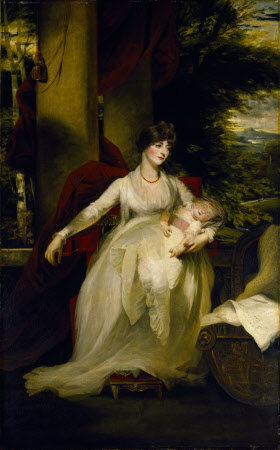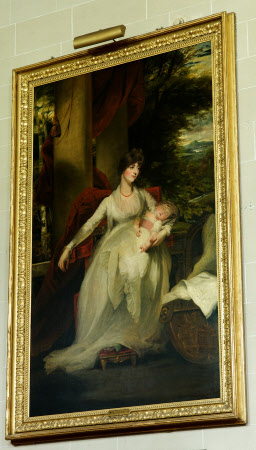Lady Caroline Paget, Lady Capel (1773-1847) holding her daughter Harriet, later Mrs David Okenden Parry-Okenden (1793 -1819)
John Hoppner, RA (London 1758 – London 1810)
Category
Art / Oil paintings
Date
circa 1793 - 1794 (exh)
Materials
Oil on canvas
Measurements
2220 x 1420 mm
Order this imageCollection
Plas Newydd, Anglesey
NT 1175932
Caption
Exhibited at the Royal Academy in 1794 as simply ‘Portrait of a Lady’, and with a dog, it is actually Lady Caroline, eldest daughter of the 1st Earl of Uxbridge, wife of the Hon. John Capel (1769—1819), first son of the 4th Earl of Essex by his second wife and sister of Henry, Lord Paget, later 2nd Earl of Uxbridge and 1st Marquess of Anglesey (1768—1854). She is shown holding her sleeping first-born child, Harriet, later Mrs David Parry-Okeden (1793—1819), the eldest of 13 children she bore. The presence of the cradle implies, as was fashionable practice by then, that Lady Caroline was nursing the child herself. The domestic intimacy of her occupation, emphasised by the naturalism of the vegetation and landscape is at odds with the grandeur of the paired-columns balustrade and looped curtain with tassels — derived from the grand aristocratic portraits painted by Rubens and Van Dyck in Genoa.
Summary
Oil painting on canvas, Lady Caroline Paget, Lady Capel (1773-1847) holding her daughter Harriet, later Mrs David Okenden Parry-Okenden (1793 -1819) by John Hoppner, RA (London 1758 – London 1810), circa 1793 - 1794. A full-length portrait of Lady Paget, shown wearing a white dress seated holding her baby Harriet, with pillars and wooded landscape in the background. She married the Hon. John Capel in 1792 and bore him 13 children, Harriet was the eldest.
Full description
Hoppner elicited one of the more splendidly dyspeptic passages of the late Prof.essor Sir Ellis Waterhouse's idiosyncratic Pelican History of Art volume on Painting in Britain: 1530-1790: "[He] admittedly had a large name in his own day, but the recent fashion for him is due chiefly to assiduous puffing by the art-trade half a century ago, and to the childlike desire of the very rich in that far-off age of collecting to fill their houses with portraits of beautiful women and lovely children. He had enough personal style usually not to leave any doubt as to whether a portrait is by him rather than by another, and yet he is or ever reminding us of the work of one or other of his greater contemporaries: at first of Reynolds and Romney, and later of Lawrence and Raeburn .... He is best in half-lengths, for his full-length ladies are little more than torrents of white muslin without form or shape .... Every one of Hoppner's borrowings and combinations is contrived, because it was calculated to please the flashy taste of those circles whose centre was the Prince of Wales .... Happily death carried him off in time for the Prince, whose taste had matured, not to be too late to give his patronage to Lawrence". This dazzling but perverse excoriation might almost have been directed at the present picture - save that, fortunately, the 6th Marquess of Anglesey (1885-1947), though he felt compelled to pull down Beaudesert in his retrenchments after the death of his heavily indebted cousin and predecessor, the 'Dancing Marquess', did not succumb to the blandishments of a Sully or Duveen, and sell his ancestors. Thus it is that no less than three whole-lengths by Hoppner (one a portrait of the future 1st Marquess of Anglesey, with a horse executed by Sawrey Gilpin), and a three-quarter length, still grace the gothick Music Room at Anglesey Abbey, as they always have . And, although, if we are to believe John Wilson, Hoppner only painted whole-lengths contre-coeur (which may indeed have been the case towards the end of his life, when his health was poor, but is less easy to believe of him in his heyday in the 1790s, when he was producing and exhibiting numbers of them at the Royal Academy), these make - with a Lawrence and other whole-lengths - as impressive a gathering of pictures of this format as one will see in any house. The family that the sitter sprang from, and the one that she married into, might both have been reckoned members of "those circles whose centre was the Prince of Wales", even if it would be unfair to describe either of them as manifesting the allegedly "flashy taste" of those. The sitter's eldest brother, Henry, Lord Paget, later 2nd Earl of Uxbridge and 1st Marquess of Anglesey (1768-1854), had a distinguished military career, commanding the cavalry at the Retreat to Corunna (1808) and at the Battle of Waterloo (1815), in which he celebratedly lost a leg. The Prince Regent promptly made him a Marquess, declaring: "that he loved him .... that he was his best officer and his best subject" ; and at his Coronation Anglesey acted as Lord High Steward. The third brother, Sir Arthur Paget (1771-1840), was a diplomat; the fourth, General Sir Edward Paget (1775-1849), commanded the reserve in the Retreat to Corunna; whilst the fifth, Vice-Admiral Sir Charles Paget (1778-1839), was in command of one of the royal yachts in attendance on the Prince Regent (1817-19), and appointed Groom of the Bedchamber to George IV in 1822. Two of the brothers' matrimonial arrangements partook of the flavour of the Regency: in 1809/10, Lord Paget, the future Marquess of Anglesey, abandoned and was divorced by his first wife, Lady Caroline 'Car' Villiers, daughter of a favourite of the Prince of Wales, the Countess of Jersey, and she then married the 6th Duke of Argyll. Lord Paget had eloped with Charlotte, _Char' Cadogan, the wife of Wellington's brother, Henry Wellesley, later Earl Cowley, and after their two divorces, married her. In 1808, Sir Arthur ran off with Lady Boringdon, née Lady Augusta Vane, marrying her in 1809, within two days of her divorce. Many years later, in 1830, Thomas, 2nd Baron Graves committed suicide because of the unbearable press and print campaign over the alleged infidelity of his wife Mary, the sitter's youngest sister, and reputedly the first lady to dance a waltz in London, with the hated Duke of Cumberland. Although these events lay in the future, the present picture, almost proclaims itself by prolepsis as a manifesto of domestic virtue. Lady Caroline Paget, the eldest daughter of the 1st Earl of Uxbridge who had been married in 1792 to the Hon. John Capel (1769-1819), the first son of the 4th Earl of Essex by his second wife, is shown holding her sleeping first-born child, Harriet, later Mrs. David Parry-Okeden (1793-1819), regardless of the fact that that child was a daughter (the eldest son, later 6th Earl of Essex, was not born until 1803), and with the child's cradle beside her (John Capel's weakness for the 'Green Table' led to the family's going to Brussels to retrench in 1814, resulting in a series of letters giving a vivid picture of society there before and after Waterloo, edited by the present Marquess of Anglesey). The implication is clearly that, in accordance with the by then fashionable practice, Lady Caroline was nursing the child herself. Interestingly, Beechey had chosen to show his own wife cradling her sleeping child only a year or so before, in even more naturalistic fashion, whereas Benjamin West's Jocosa, Lady Cust with her sleeping niece Caroline of c.1770 had, by contrast, been a modern-dress reworking of Annibale Carracci's Il Silenzio The piquancy of Hoppner's portrayal is different again, in that it resides in the contrast between the apparent domestic intimacy of Lady Caroline's occupation, which is underscored by the Reynoldsian naturalism of his treatment of the vegetation and landscape, and the rhetorical grandeur of the setting, with the full panoply of paired columns (part of no apprehensible structure) balustrade, and looped curtain with tassels - all deriving ultimately from the grand aristocratic portraits painted by Rubens and Van Dyck in Genoa. This discrepancy seems, however, to have arisen by accident: when the portrait was exhibited at the Royal Academy in 1794, simply as the Portrait of a Lady, 'Anthony Pasquin' wrote of it: "This is a spirited likeness of Lady Caroline Capel; the drapery is fancifully displaed; the dog in the foreground is ill-drawn, and the whole assemblage seem frightened!". Hoppner was very sensitive to criticism, so after this he may well have welcomed a suggestion from the sitter or her family that the dog should be painted out and the new-born child substituted. No sign of the dog or other pentimenti have ever been noticed in the picture, but it has also never been subjected to bright light or scientific examination. If no trace of dog or other alterations is to be seen, the only conclusion would have to be that Hoppner painted the portrait again from scratch - an expenditure of time that he would have been ill able to afford. It is also curious that Lady Caroline should have had the nursing child painted in over a year after it was born, since by that time she had had another daughter, Caroline, who died in infancy; possibly the sleeping child was also intended as a premonition of that loss. Notes: (i) Ellis Waterhouse, Painting in Britain: 1530-1790 [1st edn. 1953], 2nd edn., 1962, p.214. This is considerably toned down in his entry on Hoppner in The Dictionary of British 18th Century Painters, 1981, p.181. (ii) J.P. Neale, Views of Seats, 1st ser., vol.V, 1822, No.61. (ii) 'The Romantics' in The British Portrait 1660-1960, Woodbridge, 1991, pp.277-79. (iii) The [7th] Marquess of Anglesey, One-Leg, 1961, p.151, quoting a letter from Thomas, 2nd Baron Graves, to the Dowager Countess of Uxbridge. (adapted from the author's prepublicatin/unedited exhibition catalogue, Alastair Laing, In Trust for the Nation, 1995)
Marks and inscriptions
Recto: On 20th century brass label: LADY CAROLINE (PAGET) CAPEL, 1773-1847. ELDEST DAU. OF 1ST EARL OF UXBRIDGE. (see 12). JOHN HOPPNER (1758-1810), 1794. 22
Makers and roles
John Hoppner, RA (London 1758 – London 1810), artist
Exhibition history
In Trust for the Nation, National Gallery, London, 1995 - 1996, no.10
References
Neale 1818-23, 1824-9 John Preston Neale, Views of the Seats of Noblemen and Gentlemen, 1818-23, 6 vols; 2nd series, 1824-9, 1st Series, vol.V, 1822, No.61 Skipton 1905 H.P.K. Skipton, John Hoppner, 1905, pp. 64-5 McKay and Roberts 1909 William McKay and William Roberts, John Hoppner, R.A., 2 vols., London 1909-14, p.42; 2nd edn. 1914, Supplement, p.9 Steegman 1957 John Steegman, A Survey of Portraits in Welsh Houses, Vol.I: North Wales, Cardiff, 1957, p.29, No.22 Wilson 1992 John Human Wilson, The Life and Work of John Hoppner, Ph.D. dissertation, Courtauld Institute, London, June 1992, vol.I, p.181.

